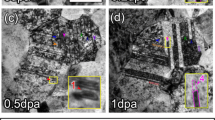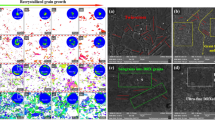Abstract
A high current density (up to 104 A•mm−2) electric current pulse (ECP) is used to cause recrystallization of a cold-rolled single phase Cu-Zn alloy directly. Since the whole treating time is the discharge time of ECP, and the duration time is very short, it is very easy to remain the non-equilibrium phase at high temperature to the room temperature to investigate the microstructural evolution during the recrystallization process. By the determination of TEM, it is found that due to the application of ECP, the original deformed twins are greatly decreased while a lot of incomplete annealing twins are emerged. Interestingly, the various morphologies of annealing twins are revealed, and the different growth directions are also observed. This phenomenon would contribute to study the variant selection of the twin in the early stage of recrystallization process.
Access this chapter
Tax calculation will be finalised at checkout
Purchases are for personal use only
Preview
Unable to display preview. Download preview PDF.
Similar content being viewed by others
References
A.F. Sprecher, S.L. Mannan, and H. Conrad, “On the temperature rise associated with the electroplastic effect in titanium,” Acta Metallurgical, 34 (1986), 1145–1162.
P.S. Ho and T. Kwok, “Electromigration in metals,” Reports on Progress in Physics, 52 (1989), 301–348.
Y.Z. Zhou, Y. Zeng, G.H. He, and B.L. Zhou, “The healing of quenched crack in 1045 steel under electropulsing,” Journal of Materials Research, 16 (2001), 17–20.
R.S. Mishra, S.H. Risbud, and A.K. Mukherjee, “Influence of initial crystal structure and electrical pulsing on densification of nanocrystalline alumina powder,” Journal of Materials Research, 13 (1998), 86–89.
W.B. Dai, X.L. Wang, H.M. Zhao, and X. Zhao, “Effect of electric current on microstructural evolution in a cold-rolled 3%Si steel,” Materials Transactions, 53 (2012), 229–233.
W. Zhang, W.S. Zhao, D.X. Li, and M.L. Sui, “Martensitic transformation from α-Ti to β-Ti on rapid heating,” Applied Physics Letters, 84 (2004), 4872–4874.
X.L. Wang, W.B. Dai, R. Wang, X.Z. Tian, and X. Zhao, “Enhanced phase transformation and variant selection by electric current pulses in a Cu-Zn alloy,” Journal of Materials Research, 29 (2014), 975–980.
H. Gleiter, “Theory of grain boundary migration rate,” Acta Metallurgica, 17 (1969), 853–918.
S. Dash, N. Brown, “An investigation of the origin and growth of annealing twins,” Acta Metallurgica, 11 (1963), 1067–1075.
M. A. Meyers, L. E. Murr, “A model for the formation of annealing twins in F.C.C. metals and alloys,” Acta Metallurgica, 26 (1978), 951–962.
B. B. Rath, M. A. Imam, and C. S. Pande, “Nucleation and growth of twin interfaces in FCC metals and alloys,” Materials Physics Mechanics, 1 (2000), 61–66.
H. Conrad and A.F. Sprecher, 1 in Dislocations in Solids (ed. F. R. N. Nabarro, Amsterdam, Elservier, 1989), 497–499.
A.F. Sprecher, S.L. Mannan, and H. Conrad, “Overview no. 49: On the mechanisms for the electroplastic effect in metals,” Acta Metallurgica, 34 (1986), 1145–1162.
X.L. Wang, W.B. Dai, C.W. Ma, and X. Zhao, “Effect of electric current direction on recrystallization rate and texture of a Cu-Zn alloy,” Journal of Materials Research, 28 (2013), 1378–1385.
D.W. Tang, B.L. Zhou, H. Cao, and G.H. He, “Thermal stress relaxation behavior in thin films under transient laser-pulse heating,” Journal of Applied Physics, 73 (1993), 3749–3752.
E.A. Brandes, Smithells Metals Reference Book (Butterworth, Washington, DC, 1983), 13–17.
C.B. Thomson, and V. Randle. “Fine tuning as ∑3n boundaries in nickel,” Acta Metallurgica, 45 (1997), 4909–4916.
X.L. Wang, W.B. Dai, R. Wang, X.Z. Tian, X. Zhao, J.M. Li, “A method to distinguish twinning variants and second twins by EBSD measurements,” Acta Metallurgica Sinica (English Letters), 27 (2014), 267–271.
Author information
Authors and Affiliations
Corresponding author
Editor information
Editors and Affiliations
Rights and permissions
Copyright information
© 2015 TMS (The Minerals, Metals & Materials Society)
About this chapter
Cite this chapter
Zhao, X., Wang, X.L., Dai, W.B., Liu, M.S., Wu, N. (2015). Twins Evolution during the Recrystallization Induced by Electric Current Pulses in a Cu-Zn Alloy. In: Fergus, J.W., Mishra, B., Anderson, D., Sarver, E.A., Neelameggham, N.R. (eds) Engineering Solutions for Sustainability. Springer, Cham. https://doi.org/10.1007/978-3-319-48138-8_9
Download citation
DOI: https://doi.org/10.1007/978-3-319-48138-8_9
Publisher Name: Springer, Cham
Print ISBN: 978-3-319-48613-0
Online ISBN: 978-3-319-48138-8
eBook Packages: EngineeringEngineering (R0)




